Create and Trace a Micronaut Application Using Oracle Cloud Infrastructure Application Performance Monitoring
This guide describes how to use the Graal Development Kit for Micronaut (GDK) to create and trace a Micronaut® application using Oracle Cloud Infrastructure Application Performance Monitoring (APM).
Oracle Cloud Infrastructure Application Performance Monitoring provides a comprehensive set of features to monitor applications and diagnose performance issues.
Tracing enables you to track service requests in a single or distributed application. Trace data shows the path, time spent in each section (called a span), and other information collected along during the trace. Tracing gives you observability into what is causing bottlenecks and failures.
Prerequisites
-
JDK 17 or higher. See Setting up Your Desktop.
-
An Oracle Cloud Infrastructure account. See Setting up Your Cloud Accounts.
-
The GDK CLI. See Setting up Your Desktop. (Optional.)
Follow the steps below to create the application from scratch. However, you can also download the completed example:
The application ZIP file will be downloaded in your default downloads directory. Unzip it and proceed to the next steps.
A note regarding your development environment
Consider using Visual Studio Code, which provides native support for developing applications with the Graal Development Kit for Micronaut Extension Pack.
Note: If you use IntelliJ IDEA, enable annotation processing.
Windows platform: The GDK guides are compatible with Gradle only. Maven support is coming soon.
1. Create the Application
Create an application using the GDK Launcher.
-
Open the GDK Launcher in advanced mode.
- Create a new project using the following selections.
- Project Type: Application (Default)
- Project Name: oci-tracing-demo
- Base Package: com.example (Default)
- Clouds: OCI
- Build Tool: Gradle (Groovy) or Maven
- Language: Java (Default)
- Test Framework: JUnit (Default)
- Java Version: 17 (Default)
- Micronaut Version: (Default)
- Cloud Services: Tracing
- Features: GraalVM Native Image (Default)
- Sample Code: Yes (Default)
- Click Generate Project, then click Download Zip. The GDK Launcher creates an application with the package
com.examplein a directory named oci-tracing-demo. The application ZIP file will be downloaded to your default downloads directory. Unzip it, open it in your code editor, and proceed to the next steps.
Alternatively, use the GDK CLI as follows:
gdk create-app com.example.oci-tracing-demo \
--clouds=oci \
--services=tracing \
--features=graalvm \
--build=gradle \
--jdk=17 \
--lang=javagdk create-app com.example.oci-tracing-demo \
--clouds=oci \
--services=tracing \
--features=graalvm \
--build=maven \
--jdk=17 \
--lang=javaOpen the micronaut-cli.yml file, you can see what features are packaged with the application:
features: [app-name, gdk-bom, gdk-license, gdk-oci-cloud-app, gdk-oci-tracing, graalvm, http-client, java, java-application, junit, logback, maven, maven-enforcer-plugin, micronaut-http-validation, netty-server, properties, readme, serialization-jackson, shade, static-resources]The GDK Launcher creates a multi-module project with two subprojects: oci for Oracle Cloud, and lib for common code and configuration shared across cloud platforms. You develop the application logic in the lib subproject, and keep the Oracle Cloud-specific configurations in the oci subproject.
1.1. Tracing Annotations
The Micronaut framework uses the io.micronaut.tracing.annotation package and OpenTelemetry to generate and export tracing data.
The io.micronaut.tracing.annotation package provides the following three annotations:
-
@NewSpan: Used on methods to create a new span; defaults to the method name, but you can assign a unique name instead. -
@ContinueSpan: Used on methods to continue an existing span; primarily used in conjunction with@SpanTag(below). -
@SpanTag: Used on method parameters to assign a value to a span; defaults to the parameter name, but you can assign a unique name instead. To use the@SpanTagon a method parameter, the method must be annotated with either@NewSpanor@ContinueSpan.
Your build configuration file contains the io.micronaut.tracing dependency which means all HTTP server methods (those annotated with @Get, @Post, and so on) create spans automatically.
1.2. InventoryService
Note: The
InventoryServiceclass demonstrates how to create and use spans fromio.micronaut.tracing.annotationand OpenTelemetry.
The GDK Launcher created the InventoryService class in a file named lib/src/main/java/com/example/InventoryService.java, as follows:
package com.example;
import io.micronaut.tracing.annotation.NewSpan;
import io.micronaut.tracing.annotation.SpanTag;
import io.opentelemetry.api.trace.Span;
import io.opentelemetry.api.trace.Tracer;
import jakarta.inject.Singleton;
import java.util.Collection;
import java.util.HashMap;
import java.util.Map;
import java.util.concurrent.ConcurrentHashMap;
@Singleton
public class InventoryService {
private static final String storeName = "my_store";
private final Tracer tracer;
private final WarehouseClient warehouse;
private final Map<String, Integer> inventory = new ConcurrentHashMap<>();
InventoryService(Tracer tracer, WarehouseClient warehouse) { (1)
this.tracer = tracer;
this.warehouse = warehouse;
inventory.put("laptop", 4);
inventory.put("desktop", 2);
inventory.put("monitor", 11);
}
public Collection<String> getProductNames() {
return inventory.keySet();
}
@NewSpan("stock-counts") (2)
public Map<String, Integer> getStockCounts(@SpanTag("inventory.item") String item) { (3)
Map<String, Integer> counts = new HashMap<>();
if (inventory.containsKey(item)) {
int count = inventory.get(item);
counts.put("store", count);
if (count < 10) {
counts.put("warehouse", inWarehouse(storeName, item));
}
}
return counts;
}
private int inWarehouse(String store, String item) {
Span.current().setAttribute("inventory.store-name", store); (4)
return warehouse.getItemCount(store, getUPC(item));
}
public void order(String item, int count) {
orderFromWarehouse(item, count);
if (inventory.containsKey(item)) {
count += inventory.get(item);
}
inventory.put(item, count);
}
private void orderFromWarehouse(String item, int count) {
Span span = tracer.spanBuilder("warehouse-order") (5)
.setAttribute("item", item)
.setAttribute("count", count)
.startSpan();
warehouse.order(Map.of(
"store", storeName,
"product", item,
"amount", count,
"upc", getUPC(item)));
span.end(); (6)
}
private int getUPC(String item) {
return Math.abs(item.hashCode());
}
}1 Inject an OpenTelemetry Tracing bean into the class.
2 Create a new io.micronaut.tracing.annotation span called "stock-counts".
3 Add a io.micronaut.tracing.annotation tag called "inventory.item" that will contain the value contained in the parameter item.
4 Get the current OpenTelemetry span and set the value of its attribute named "inventory.store-name" to the store parameter.
5 Create an OpenTelemetry span named "warehouse-order", set its attributes and start the span.
6 End the span started in 5.
1.3. Store Controller
The GDK Launcher created the StoreController class in a file named lib/src/main/java/com/example/StoreController.java, as follows:
package com.example;
import io.micronaut.http.annotation.Controller;
import io.micronaut.http.annotation.Get;
import io.micronaut.http.annotation.Post;
import io.micronaut.http.annotation.Status;
import io.micronaut.scheduling.TaskExecutors;
import io.micronaut.scheduling.annotation.ExecuteOn;
import io.micronaut.tracing.annotation.ContinueSpan;
import io.micronaut.tracing.annotation.NewSpan;
import io.micronaut.tracing.annotation.SpanTag;
import java.util.HashMap;
import java.util.List;
import java.util.Map;
import java.util.stream.Collectors;
import static io.micronaut.http.HttpStatus.CREATED;
@ExecuteOn(TaskExecutors.IO)
@Controller("/store")
class StoreController {
private final InventoryService inventory;
StoreController(InventoryService inventory) {
this.inventory = inventory;
}
@Post("/order")
@Status(CREATED)
@NewSpan("store.order") (1)
void order(@SpanTag("order.item") String item, @SpanTag int count) { (2)
inventory.order(item, count);
}
@Get("/inventory") (3)
List<Map<String, Object>> getInventory() {
return inventory.getProductNames().stream()
.map(this::getInventory)
.collect(Collectors.toList());
}
@Get("/inventory/{item}")
@ContinueSpan (4)
Map<String, Object> getInventory(@SpanTag("item") String item) { (5)
Map<String, Object> counts = new HashMap<>(inventory.getStockCounts(item));
if (counts.isEmpty()) {
counts.put("note", "Not available at store");
}
counts.put("item", item);
return counts;
}
}1 Create a new span called "store.order".
2 Add tags for the method parameters. Name the first parameter "order.item", and use the default name for the second parameter.
3 A span is created automatically if your build configuration file contains the io.micronaut.tracing dependency.
4 Required for @SpanTag (see 5).
5 Add a tag for the method parameter.
1.4. Warehouse Client
The GDK Launcher created the WarehouseClient class in a file named lib/src/main/java/com/example/WarehouseClient.java, as follows:
package com.example;
import io.micronaut.http.annotation.Get;
import io.micronaut.http.annotation.Post;
import io.micronaut.http.annotation.QueryValue;
import io.micronaut.http.client.annotation.Client;
import io.micronaut.tracing.annotation.ContinueSpan;
import io.micronaut.tracing.annotation.NewSpan;
import io.micronaut.tracing.annotation.SpanTag;
import java.util.Map;
@Client("/warehouse") (1)
public interface WarehouseClient {
@Post("/order")
@NewSpan
void order(@SpanTag("warehouse.order") Map<String, ?> json);
@Get("/count")
@ContinueSpan
int getItemCount(@QueryValue String store,
@SpanTag @QueryValue int upc);
}1 Some external service without tracing.
1.5. Warehouse Controller
The GDK Launcher created a WarehouseController class to represent an external service that will be called by WarehouseClient in a file named lib/src/main/java/com/example/WarehouseController.java, as follows:
package com.example;
import io.micronaut.http.HttpResponse;
import io.micronaut.http.annotation.Controller;
import io.micronaut.http.annotation.Get;
import io.micronaut.http.annotation.Post;
import io.micronaut.scheduling.TaskExecutors;
import io.micronaut.scheduling.annotation.ExecuteOn;
import java.util.Random;
@ExecuteOn(TaskExecutors.IO) (1)
@Controller("/warehouse") (2)
class WarehouseController {
@Get("/count") (3)
HttpResponse<?> getItemCount() {
return HttpResponse.ok(new Random().nextInt(11));
}
@Post("/order") (4)
HttpResponse<?> order() {
try {
//To simulate an external process taking time
Thread.sleep(500);
} catch (InterruptedException ignored) {
}
return HttpResponse.accepted();
}
}1 It is critical that any blocking I/O operations (such as fetching the data from the database) are offloaded to a separate thread pool that does not block the event loop.
2 The class is defined as a controller with the @Controller annotation mapped to the path /warehouse.
3 The @Get annotation maps the getItemCount method to an HTTP GET request on /warehouse/count.
4 The @Get annotation maps the order method to an HTTP GET request on /warehouse/order.
2. Setup Oracle Cloud Infrastructure Application Performance
To run tracing on Oracle Cloud Infrastructure, create an Application Performance Monitoring domain and configure the application’s tracer.
2.1. Create an Application Performance Monitoring Domain
-
Follow the steps in Create an APM Domain, using the following properties:
-
Name: Enter a name, for example, "gdk-apm-demo1".
-
Create in compartment: Select the compartment from the compartment drop-down list, or use the default.
-
Description: Enter a description, such as "A domain to demo APM with GDK".
-
-
When the APM domain is created, click its name to view its details.
-
Take note of the Data Upload Endpoint (click Copy). (This guide refers to it as <DataUploadEndpoint>, it should resemble
aaaaaaaaannaaannaa.apm-agt.us-phoenix-1.oci.oraclecloud.com.) -
Click Data Keys in the list of resources and then take note of the public key (click Copy). (This guide refers to it as [public key], it should resemble
AAANAANAANNNAAAAANNN.)
-
-
Set the following values on the command line or save them in a settings file, then run it:
export COMPARTMENT_ID="<CompartmentId>" (1) export APM_DOMAIN_NAME="<ApmDomainName>" (2)(1) Replace the value with your Compartment OCID.
(2) Set a unique APM Domain name.
-
Create an APM Domain and export its OCID:
oci apm-control-plane apm-domain create \ --compartment-id $COMPARTMENT_ID \ --display-name $APM_DOMAIN_NAME \ --description "A domain to demo APM with GDK"Note: You may have to wait up to 5 minutes before the APM Domain is in the ACTIVE state.
-
Once the APM Domain is in the ACTIVE state, retrieve its ID, which you are going to use later.
export APM_DOMAIN_OCID=$(oci apm-control-plane apm-domain list \ --compartment-id $COMPARTMENT_ID --all \ | jq -r '.data[] | select(.["display-name"] == "gcn-apm-guide-test" and .["lifecycle-state"] == "ACTIVE") | .id') -
When the APM domain is created and in ACTIVE state, run this command to get the Data Upload Endpoint:
export APM_DOMAIN_DATA_ENDPOINT=$(oci apm-control-plane apm-domain get \ --apm-domain-id $APM_DOMAIN_OCID \ | jq -r '.data."data-upload-endpoint"' | sed 's/https:\/\///') -
Get the public key from Data Keys in the list of resources. (This guide refers to it as
[public key].):https://docs.oracle.com/en-us/iaas/tools/oci-cli/3.56.0/oci_cli_docs/cmdref/apm-control-plane/data-key/list.html --apm-domain-id $APM_DOMAIN_OCID \ | jq -r '.data[] | select(.type == "PUBLIC") | .value')
-
Set the following values on the command line or save them in a settings file, then run it:
set COMPARTMENT_ID="<CompartmentId>" (1) set APM_DOMAIN_NAME="<ApmDomainName>" (2)(1) Replace the value with your Compartment OCID.
(2) Set a unique APM Domain name.
-
Create an APM Domain and export its OCID:
oci apm-control-plane apm-domain create ^ --compartment-id %COMPARTMENT_ID% ^ --display-name %APM_DOMAIN_NAME% ^ --description "A domain to demo APM with GDK"Note: You may have to wait up to 5 minutes before the APM Domain is in the ACTIVE state.
-
Once the APM Domain is in the ACTIVE state, retrieve its ID, which you are going to use later.
oci apm-control-plane apm-domain list ^ --compartment-id %COMPARTMENT_ID% --all ^ | jq -r ".data[] | select(.['display-name'] == 'gcn-apm-guide-test' and .['lifecycle-state'] == 'ACTIVE') | .id") > temp.txt set /p APM_DOMAIN_OCID=<temp.txt -
When the APM domain is created and in ACTIVE state, run this command to get the Data Upload Endpoint:
oci apm-control-plane apm-domain get ^ --apm-domain-id %APM_DOMAIN_OCID% | jq -r ".data.'data-upload-endpoint'"| sed "s/https:\/\///") > temp.txt set /p APM_DOMAIN_DATA_ENDPOINT=<temp.txt -
Get the public key from Data Keys in the list of resources. (This guide refers to it as
[public key].):oci apm-control-plane data-key list ^ --apm-domain-id %APM_DOMAIN_OCID% | jq -r ".data[] | select(.type == 'PUBLIC') | .value") > temp.txt set /p PUBLIC_KEY=<temp.txt
2.2. Configure the Tracer
APM requires you to construct a URL by using the data upload endpoint as your base URL, and generating the path based on some choices, including values from your private or public key.
To run the application, specify the otel.exporter.zipkin.path and otel.exporter.zipkin.url in oci/src/main/resources/application-oraclecloud.properties. Export those as environment values, replacing <DataUploadEndpoint> and [public key] with the values from the previous step:
export OTEL_EXPORTER_ZIPKIN_PATH="/20200101/observations/public-span?dataFormat=zipkin&dataFormatVersion=2&dataKey=[public key]"
export OTEL_EXPORTER_ZIPKIN_URL="<DataUploadEndpoint>"
set OTEL_EXPORTER_ZIPKIN_PATH=/20200101/observations/public-span?dataFormat=zipkin&dataFormatVersion=2&dataKey=[public key]
set OTEL_EXPORTER_ZIPKIN_URL=<DataUploadEndpoint>
$ENV:OTEL_EXPORTER_ZIPKIN_PATH="/20200101/observations/public-span?dataFormat=zipkin&dataFormatVersion=2&dataKey=[public key]"
$ENV:OTEL_EXPORTER_ZIPKIN_URL="<DataUploadEndpoint>"
The GDK Launcher uses these values to construct the APM Collector URL which should resemble https://aaaaaaaaannaaannaa.apm-agt.us-phoenix-1.oci.oraclecloud.com/20200101/observations/public-span?dataFormat=zipkin&dataFormatVersion=2&dataKey=AAANAANAANNNAAAAANNN.
For more information about the endpoint format, see APM Collector URL Format.
3. Run the Application
An application can send traces to APM from outside Oracle Cloud Infrastructure. This enables you to run the application locally and then view the traces in the APM Trace Explorer.
To run the application, use the following command, which starts the application on port 8080.
4. Test the Application
Test the application by accessing its REST endpoints, then review the trace output.
Open the Oracle Cloud Infrastructure APM Trace Explorer. Select the appropriate compartment and the APM domain that you created, then click Run to run the query.
It may take a few seconds for the traces to appear in the explorer. If necessary, run the query again by clicking Run, or by refreshing the page.
4.1. Get Item Count
-
Send an HTTP GET request to the
/store/inventory/{item}endpoint to get the count of an item, for example:curl http://localhost:8080/store/inventory/laptop -
Review the output in the Trace Explorer: you should see a row in the list of Traces.

-
Click the trace name to view its details. Each span is represented by a blue bar.

4.2. Order an Item
-
Send an HTTP POST request to the
/store/orderendpoint to order an item, as follows:curl -X "POST" "http://localhost:8080/store/order" \ -H 'Content-Type: application/json; charset=utf-8' \ -d $'{"item":"laptop", "count":5}' -
Review the output again in the Trace Explorer: you should see a new row that represents the trace of the order.
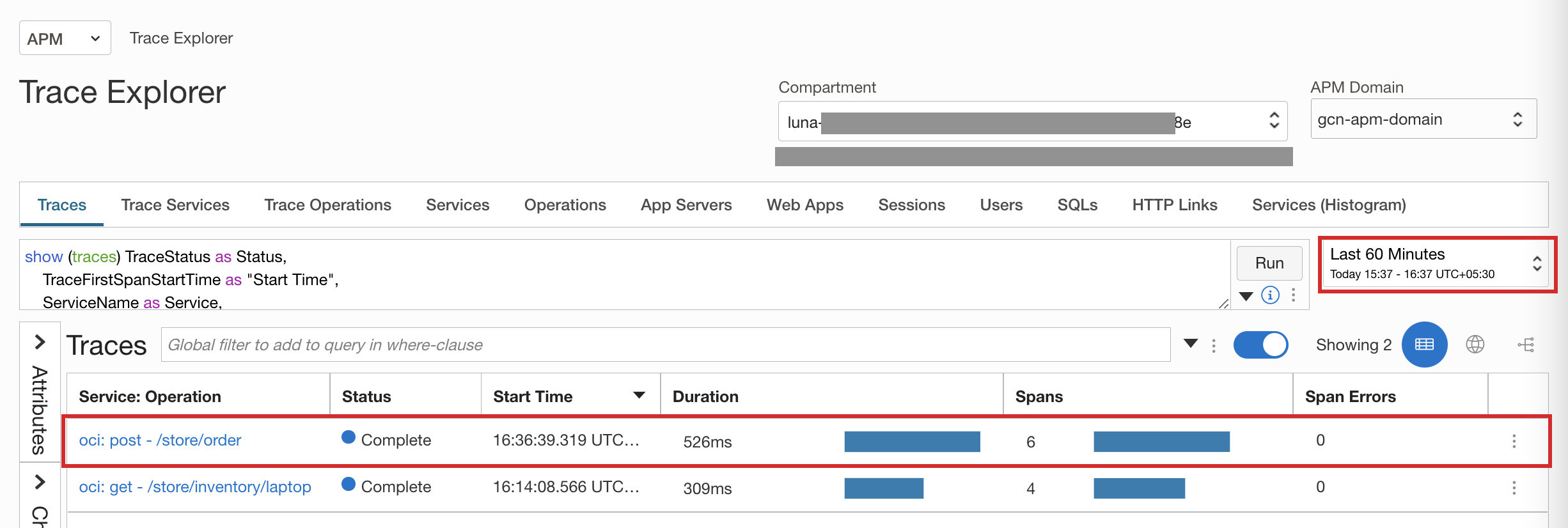
4.3. Get Inventory
-
Send an HTTP GET request to the
/store/inventoryendpoint to get the inventory:curl http://localhost:8080/store/inventory -
Review the output again in the Trace Explorer: you should see a new row that represents the trace of the request to retrieve the inventory. Click the trace name to view its details. You should see something similar to the following screenshot.
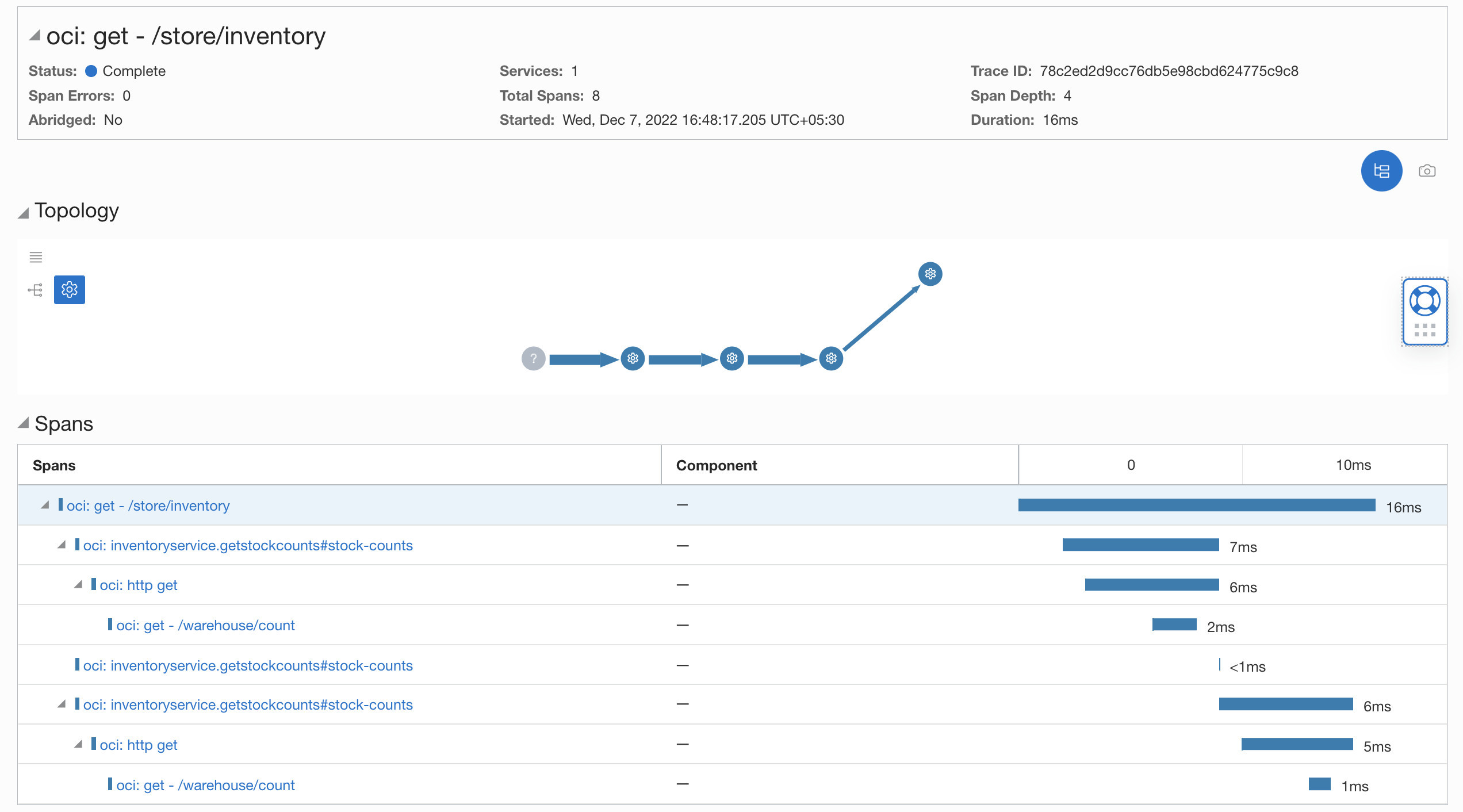
Looking at the trace, you may conclude that retrieving the items sequentially might not be the best design choice.
5. Generate a Native Executable Using GraalVM
The GDK supports compiling Java applications ahead-of-time into native executables using GraalVM Native Image. You can use the Gradle plugin for GraalVM Native Image building/Maven plugin for GraalVM Native Image building. Packaged as a native executable, it significantly reduces application startup time and memory footprint.
Prerequisites: Make sure you have installed a GraalVM JDK. The easiest way to get started is with SDKMAN!. For other installation options, visit the Downloads section.
To generate a native executable, use the following command:
./gradlew :oci:nativeCompileThe native executable oci-tracing-demo is created in the build/native/nativeCompile/ directory
./mvnw install -pl lib -am
./mvnw clean package -pl oci -Dpackaging=native-imageThe native executable oci-tracing-demo is created in the target/ directory
You can customize the name of the resulting binary by updating the Maven/Gradle plugin for GraalVM Native Image configuration.
6. Run and Test the Native Executable
Run the native executable, using the option -Dmicronaut.application.name to set the name of the application as "oci-native-demo", as follows:
oci/build/native/nativeCompile/oci-tracing-demo-oci -Dmicronaut.application.name=oci-native-demooci/target/oci-tracing-demo-oci -Dmicronaut.application.name=oci-native-demoThe native executable starts instantaneously.
6.1. Get Item Count
-
Repeat the test from step 4.1 by sending an HTTP GET request to the
/store/inventory/{item}endpoint to get the count of an item. -
Review the trace output in Trace Explorer: you should see a new row in the list of Traces that represents the request from the native executable:
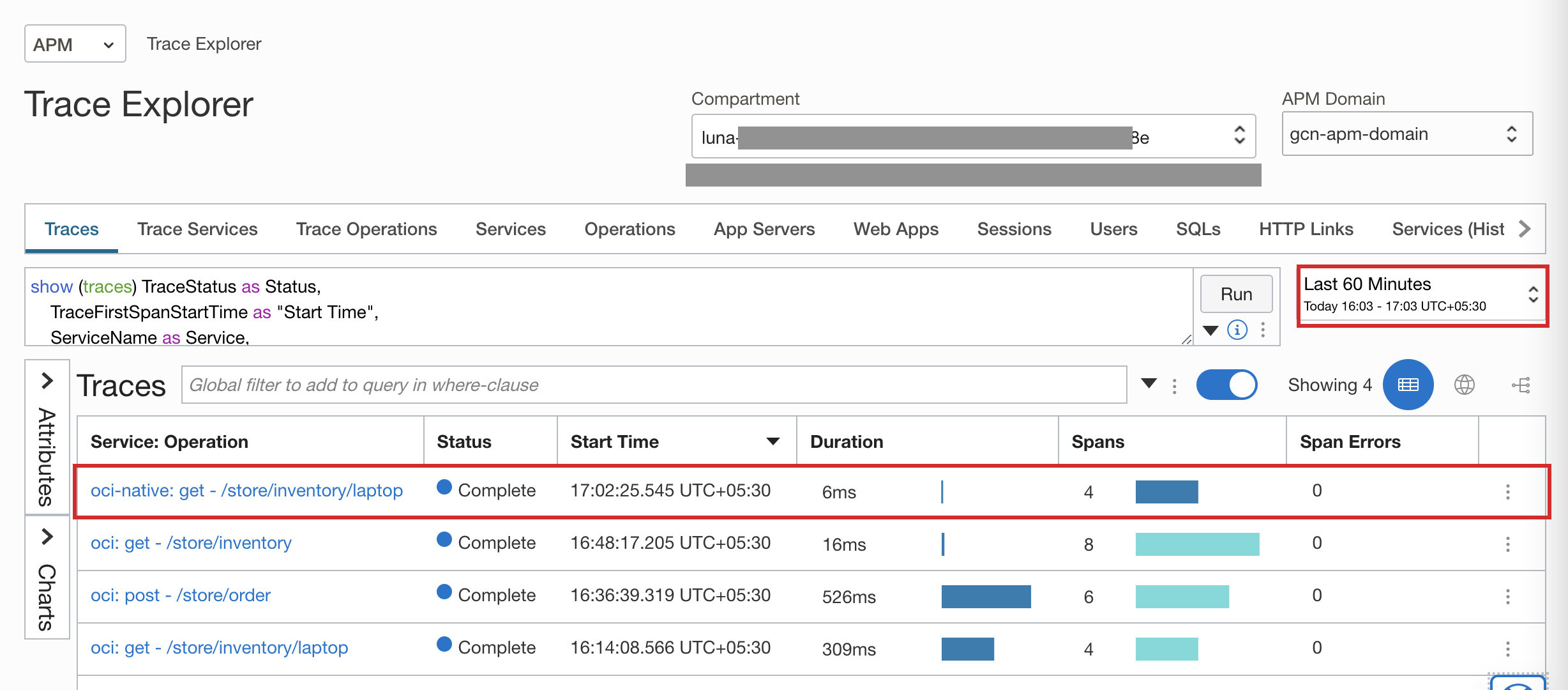
Notice that the native executable requests are processed much faster than the Java application.
-
Click the trace name to view its details. Each span is represented by a blue bar.

6.2. Order an Item
-
Repeat the test from step 4.2 by sending an HTTP POST request to the
/store/orderendpoint to order an item.You should see a new row in the Trace Explorer that represents the POST request.
Note: If you click a span, you should see its details. However, for auto-activation of custom span attributes, APM requires the attributes to be seen at least five times. Spans created prior to auto-activation will not display these attributes. This means that the custom span attributes (
countandorder.item) you added to the source code will not be displayed in the Span Details. To work around this constraint, run the command above a further ten times.You should see ten new rows in the list of Traces.

-
Click the most recent trace name to view its details.
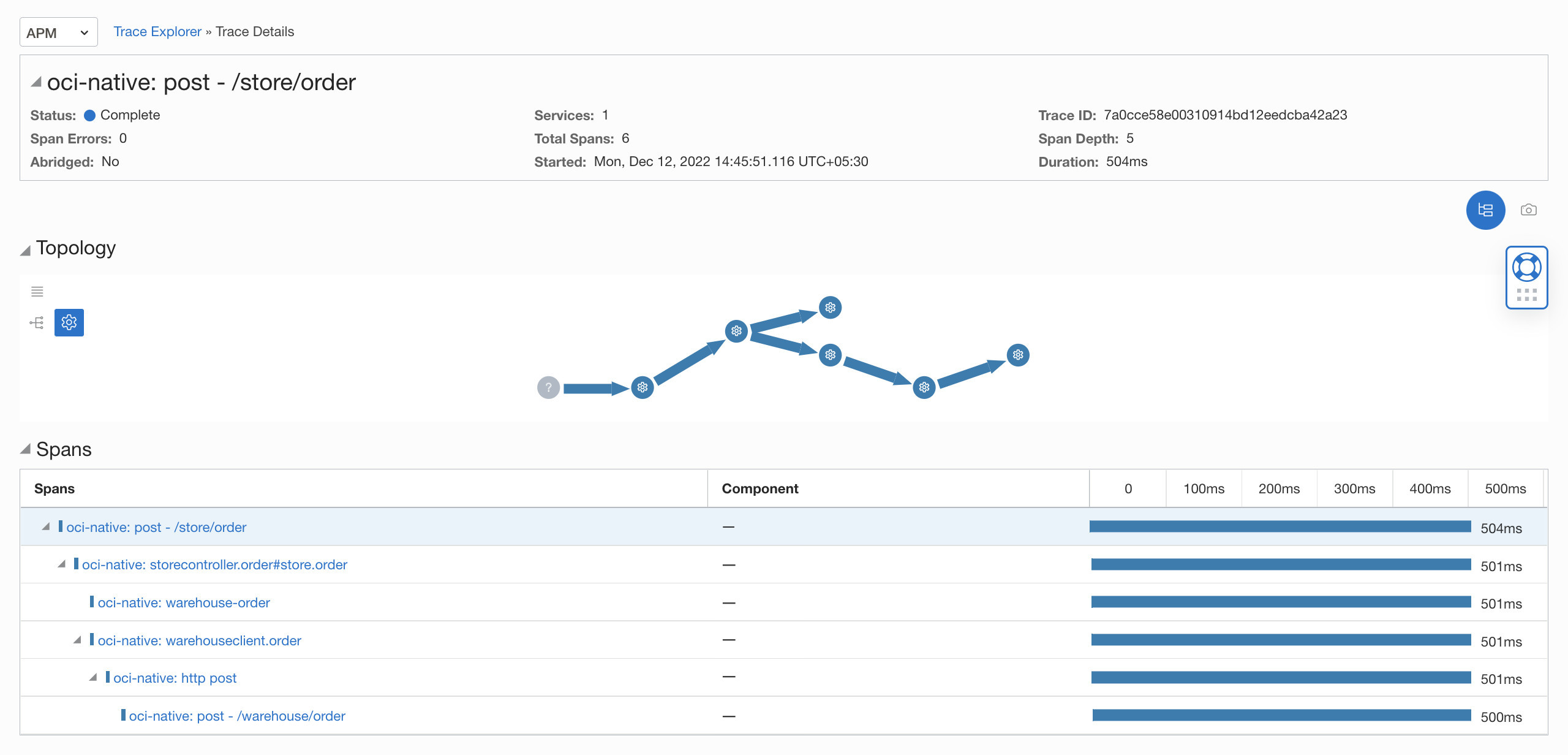
-
Click the span named
oci-native: storecontroller.order#store.orderto view its details showing the custom span attributes -countandorder.item.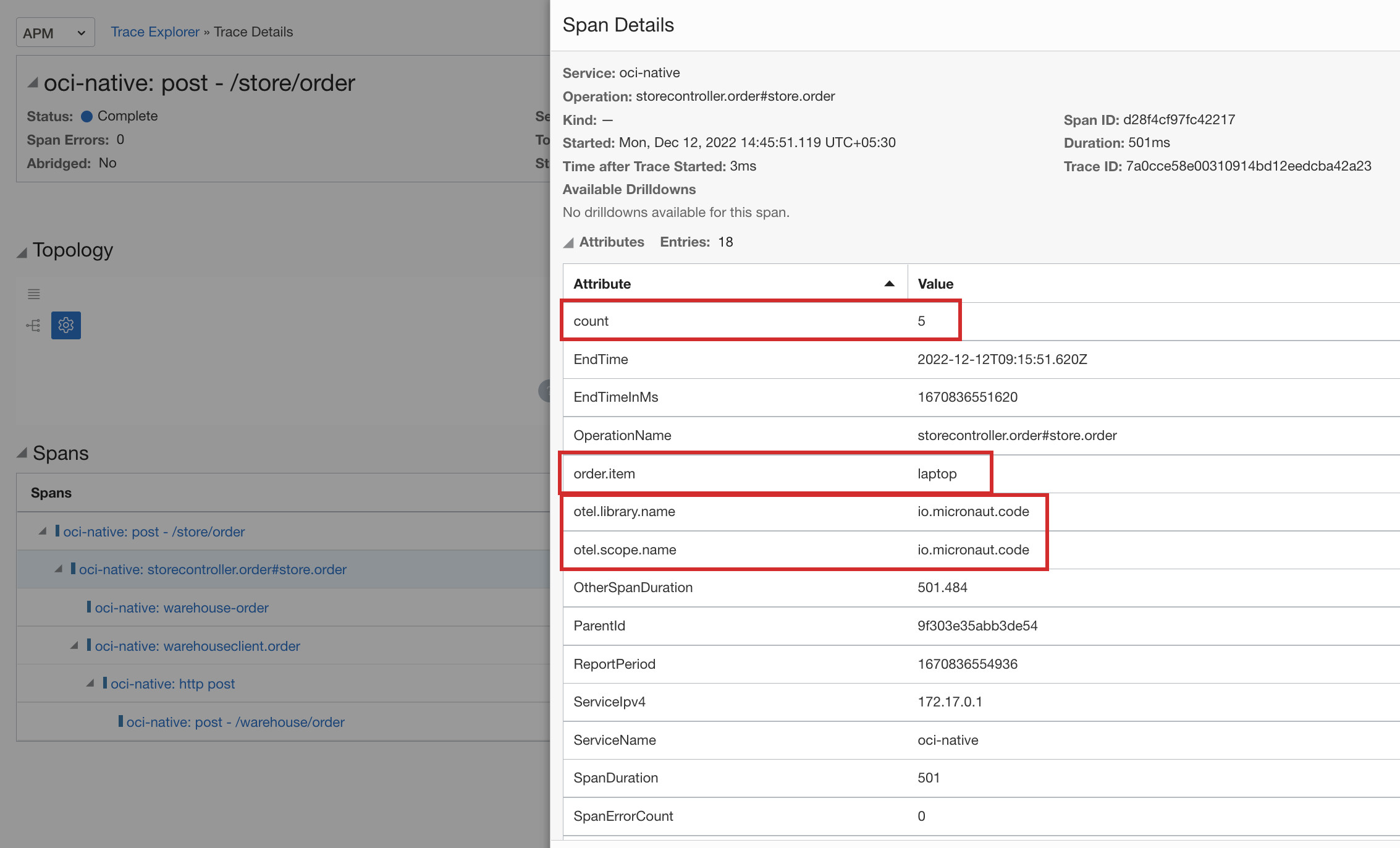
Summary
This guide demonstrated how to create and trace a Micronaut application using Oracle Cloud Infrastructure Application Performance Monitoring.
.svg)

